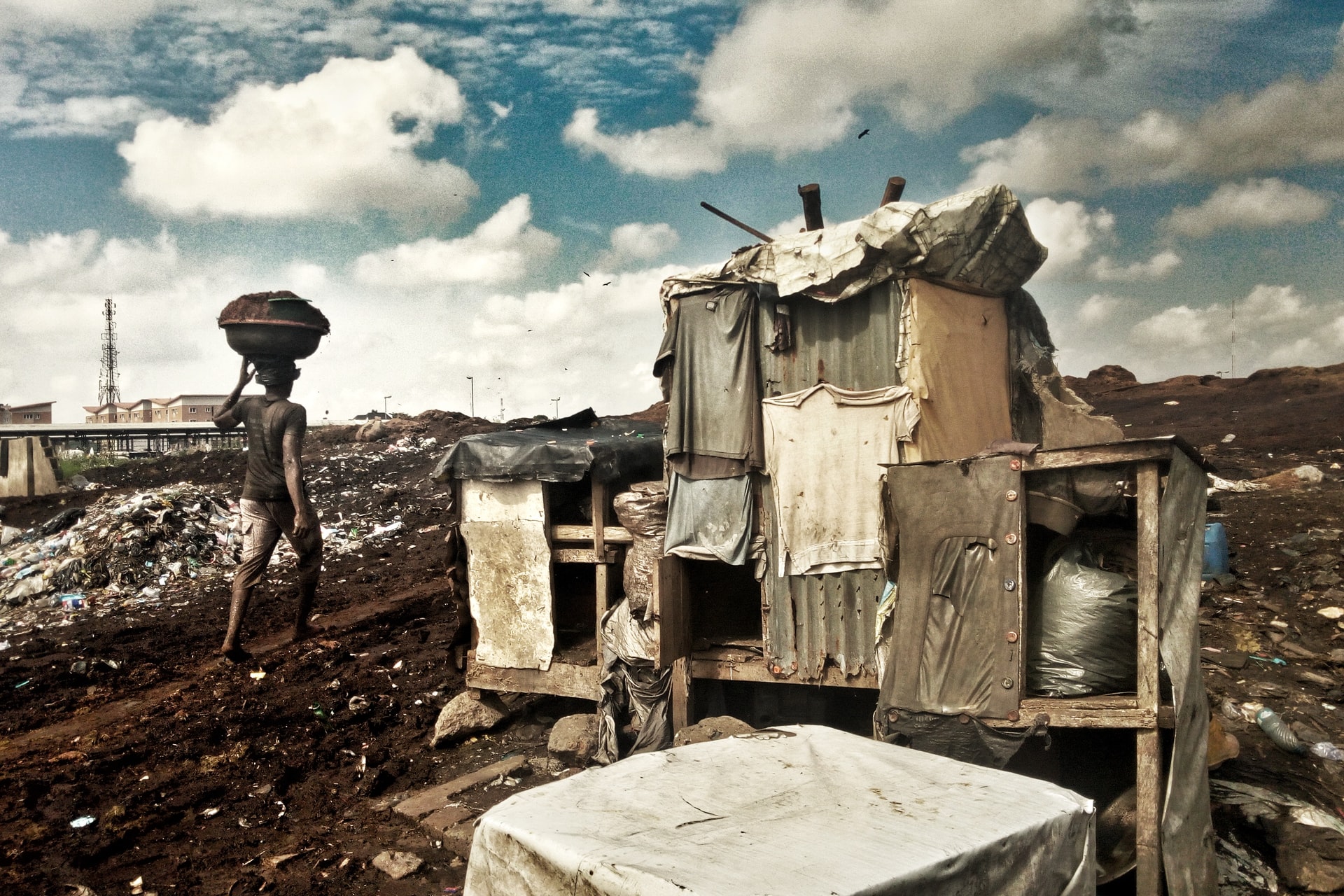
by DGR News Service | Jan 23, 2021 | Human Supremacy
by Cara Judea Alhadeff, PhD
Paintings in this post are by Micaela Amateau Amato from Zazu Dreams: Between the Scarab and the Dung Beetle, A Cautionary Fable for the Anthropocene Era.
The Master’s Tools Will Never Dismantle the Master’s House —Audre Lorde
As with our shift from our systemically racist culture to one rooted in mutual respect for multiplicity and difference, we must practice caution during our transition out of our global petroculture. This vigilance should not be based on the motivation, but on the underlying false assumptions and strategies that perceived sustainability and “alternative” agendas offer. The implicit assumptions embedded in the concept of sustainability maintains the status quo. At this juncture of geopolitical, ecological, social, and corporeal catastrophes, we must critically question clean/green solutions such as the erroneously-named Renewable Energies Revolution. I suggest we face both the roots and the implications of how perceived solutions to our climate crisis, like “renewable” energies, may unintentionally sustain ecological devastation and global wealth inequities, and actually divert us from establishing long-term, regenerative infrastructures.
On the surface, sustainability agendas appear to offer critical shifts toward an ecologically, economically, and ethically sound society, but there is much evidence to prove that #1: these structural changes must be accompanied by a psychological shift in individuals’ behavior to effectively shut down consumer-waste convenience culture; and, #2: the core of too many green/clean solutions is rooted in the very essence of our climate crisis: privatized, industrialized-corporate capitalism. For example, in his The Age of Disinformation1, Eric Cheyfitz alerts us: The Green New Deal is a “capitalist solution to a capitalist problem.” It claims to address the linked oppressions of wealth inequity and climate-crisis, yet its proposed solutions avoid the very roots of each crisis.
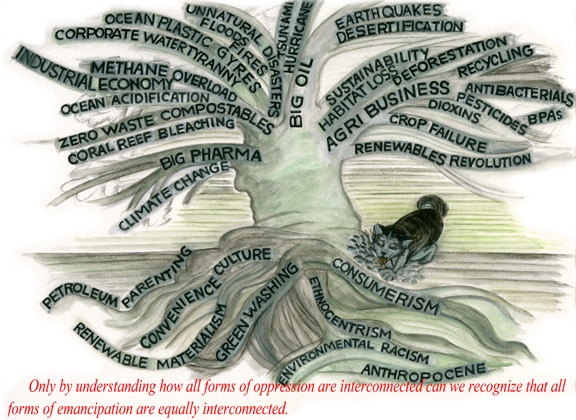
My challenge is rooted in three interrelated inquiries:
- How are our daily choices reinforcing the very racist systems we are questioning or even trying to dismantle?
- How are the alternatives to fossil-fuel economies and environmental racism reinforcing the very systems we are questioning or even trying to dismantle?
- What can we learn from indigenous philosophies and socialist ecofeminist movements in order to establish viable, sustainable, regenerative infrastructures—an Ecozoic Era?
As we transition to supposedly carbon-free electricity, we must be attentive to the ways in which we unconsciously manifest the very racist hegemonies we seek to dislodge; we must be cautious of the greening-of-capitalism that manifests as “green colonialism” through a new dependency on what is falsely identified as “renewable” energies. Currently, human and natural-world habitat destruction are implicit in the mass production and disposal infrastructures of most “renewable energies:” solar, wind, biomass/biofuels, geothermal, ethanol, hydrogen, nuclear, and other ostensible renewables2.
This includes our technocratic petroleum-pharmaceutical addictions that use technologies to create “sustainability.” Even if policy appears to be in alignment with environmental ethics, we are consistently finding that policy change simply replaces one hegemony, one cultural of domination, with another—particularly within the framework of neoliberal globalization. Only when we acknowledge the roots of our Western imperialist crisis, can we begin to decolonize and revitalize all peoples’ livelihoods and their environments.

Zazu Dreams: Between the Scarab and the Dung Beetle, A Cautionary Fable for the Anthropocene Era3, my climate justice book that explores the perils of the Anthropocene, challenges cultural habits deeply embedded in our calamitous trajectory toward global ecological and cultural, ethnic collapse. The book’s main character reflects: “We have this crazy idea that anything ‘green’ is good—but we know that there is no clear-cut good and evil. What happens when the very solution causes more problems than the original problem it was supposed to fix?”
How we measure our ecological footprint4 and global biocapacity is often riddled with paradox—particularly in the face of green colonialism, or what I call humanitarian imperialism5. The litany of our collusion with corporate forms of domination is infinite within the Anthropocene Era (increasingly characterized as the Plasticene). Disinformation campaigns spread by fossil-fuel interests deeply root us in assimilationist consumerism. The Zazu Dreams’ characters witness social and environmental costs of subjugating others through both fossil-fuel-obsessed economies and their “green” replacements. Vaclav Smil warns us of this “Miasma of falsehood.” This implies replacing one destructive socializing norm—petro-pharma cultures sustained by fossil-fuel addicted economics—with another: purportedly “renewable” energies. These energies (I don’t call them renewable, because they are not “renewable” and not carbon-free)6, like fossil-fuels, are rooted in barbaric colonialist extractive industries. Once again, the “solution” is precisely the problem. Greenwashing is a prime example of the ways in which capitalism dictates our alleged freedom. Free market is a euphemism for economic terrorism. The “green economy has come to mean…the wholesale privatization of nature.”7 Consumerism becomes the default for making supposedly ethical choices.
In Deep Green Resistance, Lierre Keith urges us: “We can’t consume our way out of environmental collapse; consumption is the problem”. Even within the 99%, consumers are capitalism. Without convenience-culture/mass consumer-demand, the machine of the profit-driven free market would have to shift gears. We can’t blame oil companies without simultaneously implicating ourselves, holding our consumption-habits equally responsible. How can we insist government and transnational corporations be accountable, when we refuse to curb our buying, using, and disposal habits? We don’t have to go far back in our cross-cultural histories of nonviolent resistance and civil disobedience to learn from world-changing examples of strikes, unions, boycotts, expropriation, infrastructural sabotage, embargoes, and divestment protests.

Yet, most contemporary transition movements are founded in the very system they are trying to dismantle. Our perceived resources, these alternative forms of energy proposed to power our public electrical grids, are misidentified under the misleading misnomers: labels such “renewable”/ “sustainable” / “clean”/ “green”. How is “clean” defined? For whom? There is not a clear division between clean energy and dirty energy/dirty power—clean isn’t always clean. Neoliberal denial of corporeal and global interrelationships instills conformist laws of conduct that continually replenish our toxic soup in which we all live. One perceived solution to help us transition is to create alternatives to fossil fuel-addicted economies, as proposed, for example, through The United States’ proposed Green New Deal and its focus on allegedly “renewable” energies. However well-intentioned, these supposed alternatives perpetuate the violence of wasteful behavior and destructive infrastructures. Even if temporarily abated, they ultimately conserve the original crisis.
Below I address specific technologies that are falsely identified as “renewable” energy; technologies that actually reinforce the very problem they are trying to solve.

1. Solar/Photovoltaic and Wind Technologies: Given the proposed solutions using industrial solar and wind harvesting, Western imperialism has and will continue to dominate global relations. “Clean energy” easily gets soiled when it is implemented on an industrial scale. Western imperialist practices are implicit in solar cell and storage production (mining and other extractive industries) and disposal infrastructures. Congruently, industrial wind farms—aka: “blenders in the sky,”(chopping up migrating birds & bats) use exorbitant resources to produce and implement (both the wind turbines and their infrastructure), and devastate migrating wildlife (bats and birds, critical to healthy ecosystems and some of whom are endangered species).
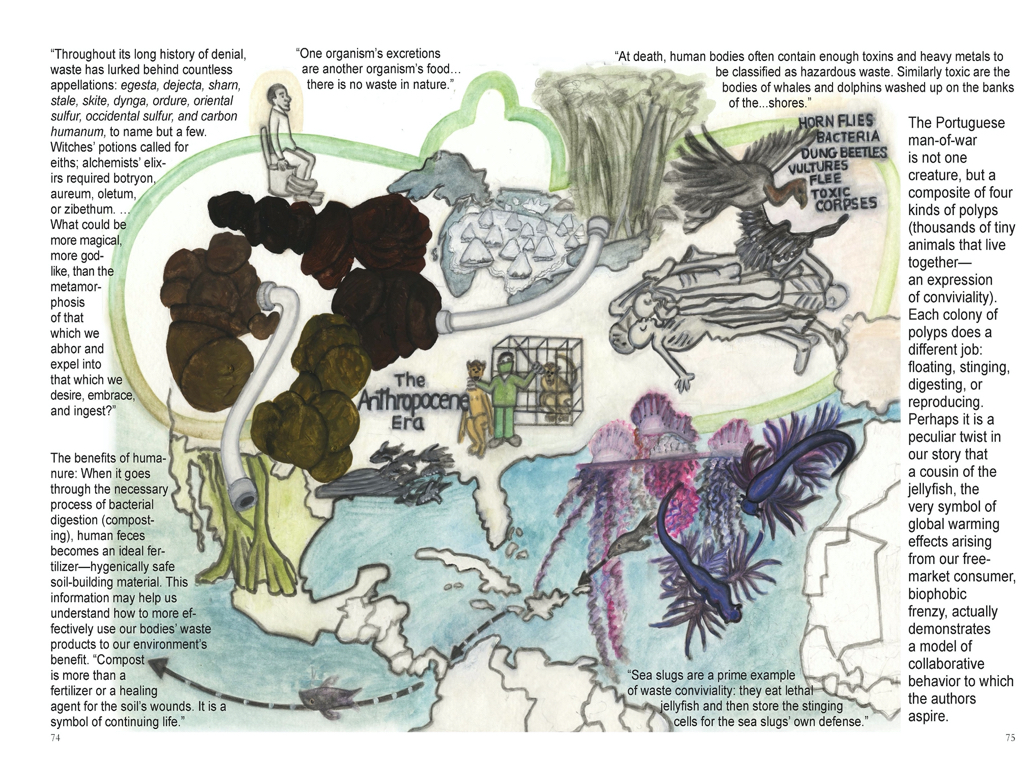
Both wind and solar energies require vast quantities of fossil fuels to implement them on a grand scale. As we have seen throughout both California and China (two examples among too many), massive solar-energy sites/solar industrial complexes strip land bare—displacing human populations and migration routes of both wildlife and people for acres of solar fields, substations, and access roads—all of which require incredibly carbon-intensive concrete. Consuming massive tracts of land, 100-1000 times more land area is required for wind and solar, as well as for biofuel energy production than does fossil-fuel production.
2. Hydro-Power Technology: Large-scale dams for hydro-power have also historically had cataclysmic effects on indigenous peoples and their lands. Although macro-hydro, like fracking, has
finally been recognized for its calamitous consequences, perversely, it is still proposed as a viable alternative to fossil-fuel economies.
3. Battery Technology: Let’s begin with a California-based scenario: According to the Union of Concerned Scientists and their Climate Vulnerability Index (CVI) in California, fine particulate pollution harms African-American communities 43% more than predominantly white communities, Latino 39% more, and Asian-American communities 21% more. As if tailpipe emissions are the only humanitarian catastrophe, one “clean solution” is the electric vehicle for public transportation and for personal consumption. Completely ignoring the embodied energy involved, this perceived solution displaces the costs of environmental racism—once again exported out of the US into the global south—in this case to Boliva where lithium (essential for battery production) is primarily mined. Cobalt, also essential to battery production, is mined in the Democratic Republic of the Congo. Like lithium, cobalt’s environmental and humanitarian costs are unconscionable—including habitat destruction, child slavery, and deaths. Eventually, production is followed by solar technology and battery e-waste dispersed throughout Asia, South America, and Africa. Additionally, rarely considered are the fossil-fuel sources used to supply the electricity for those private and public electric vehicles. And, of course most frequently, the poorest US populations work in and live near those coal mines/power plants/fracking stations.
The Renewable Energies Movement claims that our global addiction to oil (“black gold”) should be replaced by lithium (“white gold”). What we are not considering is that extracting lithium and converting it to a commercially viable form consumes copious quantities of water—drastically depleting availability for indigenous communities and wildlife, and produces toxic waste (that includes an already growing history of chemical leaks poisoning rivers, thus people and other animals). Paul Hawken‘s phrase “renewable materialism” counsels us that this hyper-idealized shift from a fossil-fuel paradigm to “renewable” energies is not a solution. Furthermore, these energies are LOW POWER DENSITY: they produce very little energy in proportion to the energy required to institutionalize them.
As the main character in Zazu Dreams prompts: “Even if we find great alternatives to fossil fuels, what if renewable energies become big business and just maintain our addiction to consumption? (…) Replacing tar sands or oil-drills or coal power plants with megalithic ‘green’ energy is not the solution—it just masks the original problem—confusing ‘freedom’ with free market and free enterprise”. We must now act on our knowledge that the renewable “revolution” is dangerously carbon intensive. And, as the authors of Deep Green Resistance caution us: “The new world of renewables will look exactly like the old in terms of exploitation.”
ENDNOTES
- Eric Cheyfitz, Age of Disinformation: The Collapse of Liberal Democracy in the United States. New York: Routledge, 2017.
- Surrogate band-aids that are frequently equal to or worse than what is being replaced include: bioplastics, phthalates replacements, and HFC’s. 1.Compostable disposables, also known as bioplastics, are most frequently produced from GMO-corn monoculture and “composted” in highly restricted environments that are inaccessible to the general public. Due to corn-crop monoculture practices that are dependent on agribusiness’s heavy use of pesticides and herbicides (for example, Monsanto’s Round-Up/glyphosate), compostable plastics are not a clean solution. Depending on their production practices, avocado pits may be a more sustainable alternative. But, the infrastructure and politics of actually “composting” these products are extraordinarily problematic. These not-so eco-friendly products rarely make it into the high temperatures needed for them to actually decompose. Additionally, their chemical compounds cause extreme damage to water, soil, and wildlife. They cause heavy acidification when they get into the water and eutrophication (lack of oxygen) when they leach nitrogen into the soil. 2.The trend to replace Bisphenol A (BPA) led to even more debilitating phthalates in products. 3.Lastly, we now know that hydrofluorocarbons (HFCs), “ozone-friendly” replacements, are equally environmentally destructive as chlorofluorocarbons (CFCs).
- Cara Judea Alhadeff, Zazu Dreams: Between the Scarab and the Dung Beetle, A Cautionary Fable for the Anthropocene Era. Berlin: Eifrig Publishing, 2017.
- The term “carbon footprint” was actually normalized through shame-propaganda by BP’s advertising campaigns. “The carbon footprint sham: A ‘successful, deceptive’ PR campaign,” Mark Kaufman, https://mashable.com/feature/carbon-footprint-pr-campaign-sham/
- Under the guise of the common good and universal values, humanitarian imperialism has emerged as a neo-colonialist method of reproducing the unquestioned status quo of industrialized, “First World” nations. For a detailed deracination of these fantasies (for example, taken-for-granted concepts of equality, poverty, standard of living), see Wolfgang Sachs’ anthology, The Development Dictionary: A Guide to Knowledge as Power. Although the term humanitarian imperialism is not explicitly used, all of the authors explore the hierarchical, ethnocentric assumptions rooted in development politics and unexamined paradigms of Progress. As public intellectuals committed to the archeology of prohibition and power distribution, we must extend this discussion beyond the context of international development politics and investigate how these normalized tyrannies thrive in our own backyard.
- The air and sun are renewable, but giant wind and solar installations are not.
- Jeff Conant, “The Dark Side of the ‘Green Economy,’” Yes! Magazine, August 2012, 63.

by DGR News Service | Jan 9, 2021 | Climate Change
Facing The Truth
by Elisabeth Robson
“In order to maintain our way of living, we must tell lies to each other, and especially to ourselves.” — Derrick Jensen
On November 6, 2020, I allowed myself one breath out, a breath of relief that a despicable administration and its despicable leader have been voted out of office. With my next breath in, I reminded myself that the administration that will replace it will be just as despicable, only in different ways. Its leaders may be more humane—perhaps they will no longer separate children from their parents at the border, and perhaps they will offer sincere sympathies to the families of those who have died of COVID-19—but they will not usher in a voluntary transition to a more sane and sustainable way of living. They may not lie about their tax returns or the size of their inauguration crowd, but they will certainly lie about many other things. More dangerously, they will lie about those things while believing they are righteous, and in so doing will convince many others to believe they are righteous, too.
One lie the Biden-Harris administration is telling that I am most immediately concerned with is the lies that the words “clean energy” and “net zero” mean something real. This lie is rooted in a fundamental denial of physical reality.
Clean Energy and Net Zero
The first and primary goal of the Biden-Harris climate plan is to
“Ensure the U.S. achieves a 100% clean energy economy and reaches net-zero emissions no later than 2050.”
Most people will, at this point, be familiar with the term “clean energy”. This usually means renewables, including wind, solar, hydropower, hydrogen, geothermal, and nuclear. These technologies are considered “clean” because the generated energy does not emit CO2 at generation time.
However, many will be less familiar with the term “net zero”. It’s understandable why so many in climate change circles, including Joe Biden and the Intergovernmental Panel on Climate Change (IPCC), would rely on the concept of “net zero” given the decline in CO2 emissions required to meet the IPCC’s stated goals of keeping global warming to “well below +2C” if we actually wanted to get our emissions to zero:
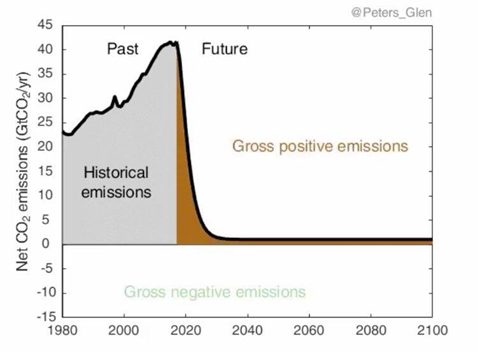
SOURCE: @Peters_Glen
The delusion of “clean energy” and “net zero” allows policy makers world wide to instead produce a graph that looks more like this:

SOURCE: Science, Vol 354, Issue 6309 14 October, 2016
This second graph is a lot more reassuring than the first. It means that we can continue to emit CO2 as long as we count on something—technology? forests? soil?—to pull extra CO2 out of the atmosphere (called carbon dioxide removal, or CDR) so we can say our CO2 emissions are “net zero” instead of zero. As long as the amount of CO2 we continue to emit is less than or equal to the CO2 we are pulling out of the atmosphere at the same time, we’re good.
We imagine that instead of facing the cliff-like drop-off in CO2 emissions in graph 1, we can follow graph 2, by gradually replacing the electricity grid with renewables producing “clean energy”, replace all 1.2 billion cars in the world with EVs, somehow figure out how to make concrete without massive amounts of fossil fuels, invent a substitute for steel that doesn’t require massive amounts of fossil fuels, replace industrial agriculture with regenerative agriculture world wide while still feeding 8 billion people, and do all this at a slower pace than within the decade or two required to get to zero emissions to avoid climate catastrophe. And, if the CDR works well enough, perhaps we imagine that we can continue to burn small amounts of fossil fuels for the foreseeable future, putting CO2 into the atmosphere and pulling it out in equal measure.
Clean energy and net zero go hand in hand, and not just in the Biden-Harris climate plan. Indeed, net zero is required for a clean energy plan to work. To see why, think about what’s required for clean energy.
Wind and Solar
To build, install, and maintain wind and solar requires not just a whole lot of mining and refining of the materials (metals and minerals) to manufacture the component parts of wind turbines and solar panels; it also requires installing the turbines and the panels in giant farms, most often on public lands where plants and animals live until they are scraped away and killed for these farms. Installing the giant turbines and panels is a fairly energy intensive process. It also requires maintaining these farms for their lifespan, which is about 25-30 years, and then dismantling and disposing of the waste at the end of that lifespan (most often in landfills) and replacing them with new wind turbines and solar panels.
It also requires building massive energy storage plants, either from batteries, which require their own energy intensive resources to make, or in energy storage schemes like pumped hydro, which requires building dams (see below). It also requires building additional grid lines to the solar and wind farms and their associated energy storage, which requires vast amounts of copper, steel, and concrete. None of this is easy to do, and all of it currently requires a whole lot of minerals and metals, which must be mined out of the ground, and energy, which is usually in the form of fossil fuels. Hmmm. That means these clean energy solutions are still emitting a lot of CO2.
Dams
To build dams requires immense amounts of concrete, and concrete is still one of the world’s most energy-intensive substances to make. It requires large, heavy machinery, running on fossil fuels, and high heat, provided by fossil fuels. And the reservoirs behind the dams often become methane producers, and methane is a greenhouse gas with 20 times the atmosphere heating qualities of CO2. The water energy must be turned into electricity, which must be transported for use or storage, requiring grid lines. Hmmm. That means that this clean energy solution is still emitting greenhouse gases, both CO2 and methane. Oh, and dams kill rivers, but that doesn’t seem to matter to clean energy advocates.
Hydrogen
Hydrogen fuel is clean when burned (meaning it produces only water at burn time), but currently requires a lot of energy to make. It is usually made from natural gas (a fossil fuel), but sometimes biomass (i.e. plants and trees). Mining natural gas emits quite a bit of methane, and cutting trees and harvesting plants emits CO2. The energy required to convert natural gas or biomass to hydrogen fuel could come from renewable sources but as we’ve seen those renewable sources are not clean. Hmmm. That means this clean energy solution is still emitting greenhouse gases into the atmosphere.
Geothermal
Geothermal might be the least bad of these bad solutions, but geothermal still requires that we build infrastructure (from steel) and power plants (to convert steam heat into electricity) and grid infrastructure to get the electricity from the source to where the electricity is used. Hmmm. All of those steps require metals, minerals, concrete, and other resources, so it would seem this clean energy solution is still emitting greenhouse gases into the atmosphere, too.
Nuclear
Everyone already knows the main downside to nuclear energy: we’ve seen these downsides first hand at Fukushima and Chernobyl and Three Mile Island. Aside from the energy required to mine uranium, build nuclear power plants, and deal with the nuclear waste (all of which requires fossil fuels), the devastating long term impacts of nuclear waste on the natural environment mean that it is perhaps the epitome of delusion to consider nuclear energy clean in any way.
So, even if we were somehow to run our “clean energy economy” on electricity from renewables alone, we’d still be far from zero CO2 emissions. Which is why we need “net zero”. We need a way to offset the CO2 and other greenhouse gas emissions that will happen in the energy sector even if we were to somehow replace fossil fuels with renewables world wide. This accounting also does not include the emissions from other sectors producing greenhouse gas emissions, such as industrial agriculture, transportation, and industry (even if industry is run on renewables for its energy, large amounts of greenhouse gases are released during manufacturing from chemical reactions, as an example).
Negative Emissions Technologies
So what is the future something that we will rely on to pull CO2 from the air so we can get to net zero emissions? It’s a suite of technologies known as negative emissions technologies.
In a 2018 report on negative emissions technologies, the United Nations Framework on Climate Change Convention (UNFCCC, with 197 countries participating) includes the following technologies: reforestation and afforestation, land management, enhanced weathering, ocean fertilization, bioenergy with carbon capture and storage (BECCS), direct air capture and carbon storage (DACCS), and carbon capture and storage (CCS).
Nature-based NETs
Reforestation and afforestation means planting a whole lot of trees. It means reforesting the areas we’ve deforested, and it means planting trees in areas that were not previously forested. The thinking is that trees pull CO2 from the air as they grow. Of course, before industrial civilization, there were a whole lot more trees, and those trees were part of the normal carbon cycle of the Earth, pulling CO2 out of the air in balance with the amount of CO2 emitted by normal processes that are part of life and death on this planet. So to get more CO2 pulled from the atmosphere to offset the industrial emissions from fossil fuels and other man-made sources of greenhouse gases, we’d have to plant a whole lot more trees.
This at a time when deforestation continues apace for mining, development, and industrial agriculture, and at a time when population continues to grow and land is regularly cleared of forest in order to produce the vast quantities of food to feed that growing population. Unfortunately, many tree planting schemes concocted for carbon offsets tend to be mono-crops of trees, rather than forests, and so don’t contribute to increasing viable habitat for wildlife at the same time. In addition, if trees are planted in the wrong place, this can often do more harm than good. It is hard to argue against planting more trees (if done well, and in the right places), but given we continue to deforest more than reforest, it seems unlikely this solution is viable.
Increasing carbon storage in soil through land management:
including regenerative agriculture and biochar, could store up to 0.7 gigatons of carbon (GtC) a year from the atmosphere, according to the UNFCC, and perhaps more if the depth of carbon storage is increased significantly with deeper soils. Keep in mind, that the total GtC released into the atmosphere from fossil fuels is about 10 GtC a year, and that carbon capture in soil would require completely overhauling global industrial agriculture at a time when industrial agriculture is rapidly expanding to feed the world’s growing population.
Enhanced weathering
Enhanced weathering is a technique to increase the rate of CO2 absorption in slow natural mechanisms that remove CO2 from the air, such as rock weathering, by applying chemicals to rocks, or by spreading finely ground rock over large areas of land. This is a purely speculative NET since no studies have been done at scale on the process.
Ocean fertilization
Ocean fertilization is the process of adding fertilizer, typically iron, to the ocean to increase the uptake of CO2 by plankton algae. Only small tests have been done with ocean fertilization, including one rogue fisherman who dumped 100 tons of iron dust in the waters off Canada. As the UNFCCC states in its report, ocean fertilization is “associated with very high levels of uncertainty and ecological risks for relatively small sequestration potential.”
My conclusion is that manipulating nature to reduce atmospheric CO2 has limited potential at best, and the risk of damaging the natural ecology of the Earth at worst.
Technology NETs
That leaves technology. The technologies included in the UNFCCC report are carbon capture and storage (CCS), bioenergy with CCS, and direct air CCS. CCS is really just a catch all name for BECCS and DACCS, as well as the ecosystem manipulation techniques described above.
BECCS requires replacing the fossil fuels burned in power plants world wide with biomass fuels, and adding technology that can capture the CO2 emitted when burning the biomass. Estimates of the amount of land required to grow the biomass to replace electricity at current levels of demand are about twice the size of India. Needless to say this would be problematic not just for food production, but also the reforestation and afforestation plans mentioned above. Another major problem with BECCS is that capturing CO2 in power plants is still highly speculative, has been demonstrated in only a few power plants, and the captured CO2 is most often used for “enhanced oil recovery”—i.e. getting more oil out of the ground—rather than stored. As of 2012 there were 62,500 power plants operating around the world, and 18 of them can now capture carbon. I’ll leave you to do the math.
If we add CO2 capture to all existing, non-biomass burning power plants, this will reduce the CO2 emitted from fossil fuels at burn time, but will do nothing to stop the destructive mining to get the fossil fuels from the ground. Existing coal power plants that have been converted to biomass typically burn wood pellets, some of which come from forests cut down to provide that wood, which seems counterproductive given the first NET discussed above, requiring that we plant more trees, not cut more of them down. In addition, it takes more wood to produce the same energy as you’d get from burning coal, so more CO2 is emitted, and because of the long lag time in tree regrowth and associated carbon sequestration, it quickly becomes clear that burning biomass will add more CO2 to the atmosphere during the critical near-term time period we need to be rapidly decarbonizing.
This is a well-known loophole in CO2 accounting schemes, and yet biomass burning has been enthusiastically embraced by power plants as an easy way to reuse current technology without having to account for the CO2 emitted.
DACCS is another speculative technology that uses giant fans to bring air into reactors made with plastic and potassium hydroxide to bind with CO2 and remove it from the air.
The CO2 is then purified and processed with “chemicals” (I’m not sure which chemicals, it seems to be proprietary information)—a process that requires energy, of course—and the resulting pure CO2 can then be stored to keep it out of the atmosphere. However, to pay for the technology and energy required to capture CO2, rather than being stored, the captured CO2 is typically used for enhanced oil recovery, which would seem to make the entire process moot. Indeed, one of the most well known of the DACCS companies operating today, Carbon Engineering, partnered with Chevron in 2019 in order to use the captured CO2 to pump more oil and gas.
If the captured CO2 from both BECCS and DACCS is to be stored, which is necessary to prevent it from heating the atmosphere, the CO2 must be stored forever. So far the most promising technique for storing CO2 long-term is to mix it with water and inject it into basalt (volcanic) rock, where it reacts with the rock and remineralizes. This technique has been demonstrated in only a small number of experiments. If one imagines power plants and direct capture infrastructure capturing CO2 all around the world, this also begs the question of how to get the captured CO2 to locations where it can be stored into rock, remembering that the world currently emits about 40 GtCO2 a year, which is a huge amount of CO2. Would we use pipelines? And if so, how do we build the pipelines without a whole lot of steel and fossil fuels? Other techniques for storing CO2 are to put it in old salt mines or to replace oil extracted from the ground, but both of these storage techniques have limitations in a world with regular earthquakes, seepy rock, and human error.
In sum, none of the negative emissions technologies discussed in the UNFCCC report sound particularly hopeful, and even the UNFCCC admits in its own report that
“these technologies offer only limited realistic potential to remove carbon from the atmosphere.”
Policy Delusions
Despite this, the IPCC states in a post dated July 31, 2020, that
“global emissions need to be reduced to net-zero within the next few decades to avoid a dangerous increase in global temperatures”
and that
“the good news is we already have affordable, reliable technologies that can put the peak in global emissions behind us and start the drive down to net zero.”
They continue,
“Deployed quickly and on a major scale, the clean energy technologies we have at our disposal right now can bring about the kind of decline in energy-related emissions that would put the world on track for our longer-term climate goals.”
Governments around the world, including the United States, look to the IPCC for guidance on making policy related to climate change and yet this guidance is clearly delusional.
The list of lies one must tell oneself in order to believe this rhetoric is long:
- renewable energy and associated technologies (e.g. electric vehicles) is “clean”;
- deploying renewable energy world wide in time to avoid climate catastrophe is possible or even desirable;
- mining and refining the metals and minerals required to build that renewable energy is an acceptable further destruction to the natural world at a time when scientists are telling us habitat loss and biodiversity loss and extinction are crises just as important as climate change;
- that it’s okay for us to target “net zero” emissions rather than zero emissions because we have faith we’ll have the technology we need to pull CO2 from the air,
- that we can deploy these technologies globally in time to prevent catastrophic climate change;
- and perhaps worst of all, that any of this can be called “environmental justice” for those most impacted—the land, rivers, lakes, plants, and human and non-human animals whose homes and lives are lost to mining, industry, and technology.
Nowhere does the Biden-Harris plan for the future make mention of de-growth, reducing industry or the military, or reducing consumption. Nowhere. In fact we see the opposite: the catch phrase for the Biden-Harris administration is “build back better”. Build back to what? The unsustainable lifestyle to which we have become accustomed? A life of jumping on planes to the nearest tourist destination, where we buy crap we don’t need and throw away six months later? A life of building more houses, more roads, and bigger and more productive corporations with the municipal and industrial waste that goes with that? A life with a military that is the worst polluter in the United States and requires a constant supply of fossil fuels, metals, and minerals mined from the ground? Biden claims he wants to “build prosperity”. Does he understand that true prosperity is created by healthy ecosystems, because without healthy, flourishing, fecund ecosystems, there is no life on Earth? We live in a world where eight people have more wealth that most of the rest of the world combined. How is that prosperity helping the natural world? How is that prosperity being used to stop the destruction? The answer is obvious: it isn’t.
These are just a few of the lies we must tell to each other, and especially ourselves, if we wish to go along quietly with the policies outlined in the Biden-Harris plan for the next four years.
However, if you cannot lie to yourself or your loved ones, speak up. Tell the truth. Face ecological reality. This is no time for delusion, unless we are ready to ignore the suffering around us and give up on this beautiful planet we call home.
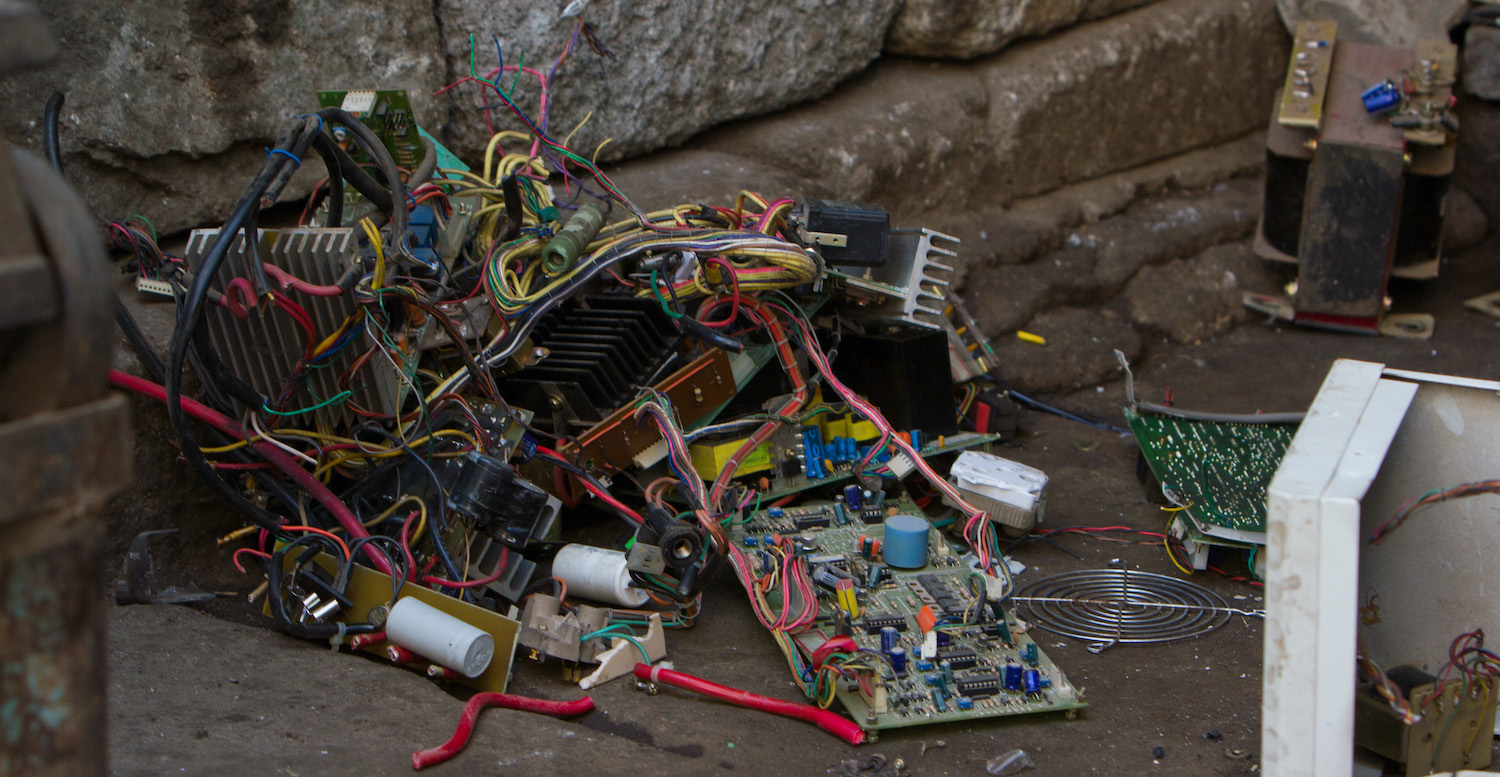
by DGR News Service | Sep 15, 2020 | Climate Change, Mining & Drilling, The Problem: Civilization
This is the fourth part in the series. In the previous essays, we have explored the need for a collapse, the relationship between a Dyson sphere and overcomsumption, and our blind pursuit for ‘progress.’ In this piece, Elisabeth describes how the Dyson sphere is an extension of the drive for so-called “green energy.”
By Elisabeth Robson
Techno-utopians imagine the human population on Earth can be saved from collapse using energy collected with a Dyson Sphere–a vast solar array surrounding the sun and funneling energy back to Earth–to build and power space ships. In these ships, we’ll leave the polluted and devastated Earth behind to venture into space and populate the solar system. Such a fantasy is outlined in “Deforestation and world population sustainability: a quantitative analysis” and is a story worthy of Elon Musk and Jeff Bezos. It says, in so many words: we’ve trashed this planet, so let’s go find another one.
In their report, Mauro Bologna and Gerardo Aquino present a model that shows, with continued population growth and deforestation at current rates, we have a less than 10% chance of avoiding catastrophic collapse of civilization within the next few decades. Some argue that a deliberate and well-managed collapse would be better than the alternatives. Bologna and Aquino present two potential solutions to this situation. One is to develop the Dyson Sphere technology we can use to escape the bonds of our home planet and populate the solar system. The other is to change the way we (that is, those of us living in industrial and consumer society) live on this planet into a ‘cultural society’, one not driven primarily by economy and consumption, in order to sustain the population here on Earth.
The authors acknowledge that the idea of using a Dyson Sphere to provide all the energy we need to populate the solar system is unrealistic, especially in the timeframe to avoid collapse that’s demonstrated by their own work. They suggest that any attempt to develop such technology, whether to “live in extraterrestrial space or develop any other way to sustain population of the planet” will take too long given current rates of deforestation. As Salonika describes in an earlier article in this series, “A Dyson Sphere will not stop collapse“, any attempt to create such a fantastical technology would only increase the exploitation of the environment.
Technology makes things worse
The authors rightly acknowledge this point, noting that “higher technological level leads to growing population and higher forest consumption.” Attempts to develop the more advanced technology humanity believes is required to prevent collapse will simply speed up the timeframe to collapse. However, the authors then contradict themselves and veer back into fantasy land when they suggest that higher technological levels can enable “more effective use of resources” and can therefore lead, in principle, to “technological solutions to prevent the ecological collapse of the planet.”
Techno-utopians often fail to notice that we have the population we do on Earth precisely because we have used technology to increase the effectiveness (and efficiency) of fossil fuels and other resources* (forests, metals, minerals, water, land, fish, etc.). Each time we increase ‘effective use’ of these resources by developing new technology, the result is an increase in resource use that drives an increase in population and development, along with the pollution and ecocide that accompanies that development. The agricultural ‘green revolution’ is a perfect example of this: advances in technology enabled new high-yield cereals as well as new fertilizers, pesticides, herbicides, irrigation, and mechanization, all of which prevented widespread famine, but also contributed to an ongoing explosion in population, development, chemical use, deforestation, land degradation and salinization, water pollution, top soil loss, and biodiversity loss around the world.
As economist William Stanley Jevons predicted in 1865, increasing energy efficiency with advances in technology leads to more energy use. Extrapolating from his well-proved prediction, it should be obvious that new technology will not prevent ecological collapse; in fact, such technology is much more likely to exacerbate it.
This mistaken belief that new technology can save us from collapse pervades the policies and projects of governments around the world.
Projects like the Green New Deal, the Democrat Party’s recently published climate plan, and the UN’s sustainable development goals and IPCC recommendations. All these projects advocate for global development and adoption of ‘clean technology’ and ‘clean industry’ (I’m not sure what those terms mean, myself); ’emissions-free’ energy technologies like solar, wind, nuclear and hydropower; and climate change mitigation technologies like carbon capture and storage, smart grids, artificial intelligence, and geo-engineering. They tout massive growth in renewable energy production from wind and solar, and boast about how efficient and inexpensive these technologies have become, implying that all will be well if we just keep innovating new technologies on our well worn path of progress.
Miles and miles of solar panels, twinkling like artificial lakes in the middle of deserts and fields; row upon row of wind turbines, huge white metal beasts turning wind into electricity, and mountain tops and prairies into wasteland; massive concrete dams choking rivers to death to store what we used to call water, now mere embodied energy stored to create electrons when we need them–the techno-utopians claim these so-called clean’ technologies can replace the black gold of our present fantasies–fossil fuels–and save us from ourselves with futuristic electric fantasies instead.
All these visions are equally implausible in their capacity to save us from collapse.
And while solar panels, wind turbines, and dams are real, in the sense that they exist–unlike the Dyson Sphere–all equally embody the utter failure of imagination we humans seem unable to transcend. Some will scoff at my dismissal of these electric visions, and say that imagining and inventing new technologies is the pinnacle of human achievement. With such framing, the techno-utopians have convinced themselves that creating new technologies to solve the problems of old technologies is progress. This time it will be different, they promise.
And yet if you look at the graph of global primary energy consumption:

it should be obvious to any sensible person that new, so-called ‘clean’ energy-producing technologies are only adding to that upward curve of the graph, and are not replacing fossil fuels in any meaningful way. Previous research has shown that “total national [US] energy use from non-fossil-fuel sources displaced less than one-quarter of a unit of fossil-fuel energy use and, focussing specifically on electricity, each unit of electricity generated by non-fossil-fuel sources displaced less than one-tenth of a unit of fossil-fuel-generated electricity.”
In part, this is due to the fossil fuel energy required to mine, refine, manufacture, install, maintain, and properly dispose of materials used to make renewable and climate mitigation technologies. Mining is the most destructive human activity on the planet, and a recent University of Queensland study found that mining the minerals and metals required for renewable energy technology could threaten biodiversity more than climate change. However, those who use the word “clean” to describe these technologies conveniently forget to mention these problems.
Wind turbines and solar arrays are getting so cheap; they are being built to reduce the cost of the energy required to frack gas: thus, the black snake eats its own tail. “Solar panels are starting to die, leaving behind toxic trash”, a recent headline blares, above an article that makes no suggestion that perhaps it’s time to cut back a little on energy use. Because they cannot be recycled, most wind turbine blades end up in landfill, where they will contaminate the soil and ground water long after humanity is a distant memory. Forests in the southeast and northwest of the United States are being decimated for high-tech biomass production because of a loophole in EU carbon budget policy that counts biomass as renewable and emissions free. Dams have killed the rivers in the US Pacific Northwest, and salmon populations are collapsing as a result. I could go on.
The lies we tell ourselves
Just like the Dyson Sphere, these and other technologies we fantasize will save our way of life from collapse are delusions on a grand scale. The governor of my own US state of Washington boasts about how this state’s abundant “clean” hydropower energy will help us create a “clean” economy, while at the same time he fusses about the imminent extinction of the salmon-dependent Southern Resident Orca whales. I wonder: does he not see the contradiction, or is he willfully blind to his own hypocrisy?
The face of the Earth is a record of human sins (1), a ledger written in concrete and steel; the Earth twisted into skyscrapers and bridges, plows and combines, solar panels and wind turbines, mines and missing mountains; with ink made from chemical waste and nuclear contamination, plastic and the dead bodies of trees. The skies, too, tell our most recent story. Once source of inspiration and mythic tales, in the skies we now see airplanes and contrails, space junk and satellites we might once have mistaken for shooting stars, but can no longer because there are so many; with vision obscured by layers of too much PM2.5 and CO2 and NOx and SO2 and ozone and benzene. In the dreams of techno-utopians, we see space ships leaving a rotting, smoking Earth behind.
One of many tales of our Earthly sins is deforestation.
As the saying goes, forests precede us, and deserts follow; Mauro Bologna and Gerardo Aquino chose a good metric for understanding and measuring our time left on Earth. Without forests, there is no rain and the middles of continents become deserts. It is said the Middle East, a vast area we now think of as primarily desert, used to be covered in forests so thick and vast the sunlight never touched the ground (2). Without forests, there is no home for species we’ve long since forgotten we are connected to in that web of life we imagine ourselves separate from, looking down from above as techno-gods on that dirty, inconvenient thing we call nature, protected by our bubble of plastic and steel. Without forests, there is no life.
One part of one sentence in the middle of the report gives away man’s original sin: it is when the authors write, “our model does not specify the technological mechanism by which the successful trajectories are able to find an alternative to forests and avoid collapse“. Do they fail to understand that there is no alternative to forests? That no amount of technology, no matter how advanced–no Dyson Sphere; no deserts full of solar panels; no denuded mountain ridges lined with wind turbines; no dam, no matter how wide or high; no amount of chemicals injected into the atmosphere to reflect the sun–will ever serve as an “alternative to forests”? Or are they willfully blind to this fundamental fact of this once fecund and now dying planet that is our only home?
A different vision
I’d like to give the authors the benefit of the doubt, as they end their report with a tantalizing reference to another way of being for humans, when they write, “we suggest that only civilisations capable of a switch from an economical society to a sort of ‘cultural’ society in a timely manner, may survive.” They do not expand on this idea at all. As physicists, perhaps the authors didn’t feel like they had the freedom to do so in a prestigious journal like Nature, where, one presumes, scientists are expected to stay firmly in their own lanes.
Having clearly made their case that civilized humanity can expect a change of life circumstance fairly soon, perhaps they felt it best to leave to others the responsibility and imagination for this vision. Such a vision will require not just remembering who we are: bi-pedal apes utterly dependent on the natural world for our existence. It will require a deep listening to the forests, the rivers, the sky, the rain, the salmon, the frogs, the birds… in short, to all the pulsing, breathing, flowing, speaking communities we live among but ignore in our rush to cover the world with our innovations in new technology.
Paul Kingsnorth wrote: “Spiritual teachers throughout history have all taught that the divine is reached through simplicity, humility, and self-denial: through the negation of the ego and respect for life. To put it mildly, these are not qualities that our culture encourages. But that doesn’t mean they are antiquated; only that we have forgotten why they matter.”
New technologies, real or imagined, and the profits they bring is what our culture reveres.
Building dams, solar arrays, and wind turbines; experimenting with machines to capture CO2 from the air and inject SO2 into the troposphere to reflect the sun; imagining Dyson Spheres powering spaceships carrying humanity to new frontiers–these efforts are all exciting; they appeal to our sense of adventure, and align perfectly with a culture of progress that demands always more. But such pursuits destroy our souls along with the living Earth just a little bit more with each new technology we invent.
This constant push for progress through the development of new technologies and new ways of generating energy is the opposite of simplicity, humility, and self-denial. So, the question becomes: how can we remember the pleasures of a simple, humble, spare life? How can we rewrite our stories to create a cultural society based on those values instead? We have little time left to find an answer.
* I dislike the word resources to refer to the natural world; I’m using it here because it’s a handy word, and it’s how most techno-utopians refer to mountains, rivers, rocks, forests, and life in general.
(1) Susan Griffin, Woman and Nature
(2) Derrick Jensen, Deep Green Resistance
In the final part of this series, we will discuss what the cultural shift (as described by the authors) would look like.
Featured image: e-waste in Bangalore, India at a “recycling” facility. Photo by Victor Grigas, CC BY SA 3.0.
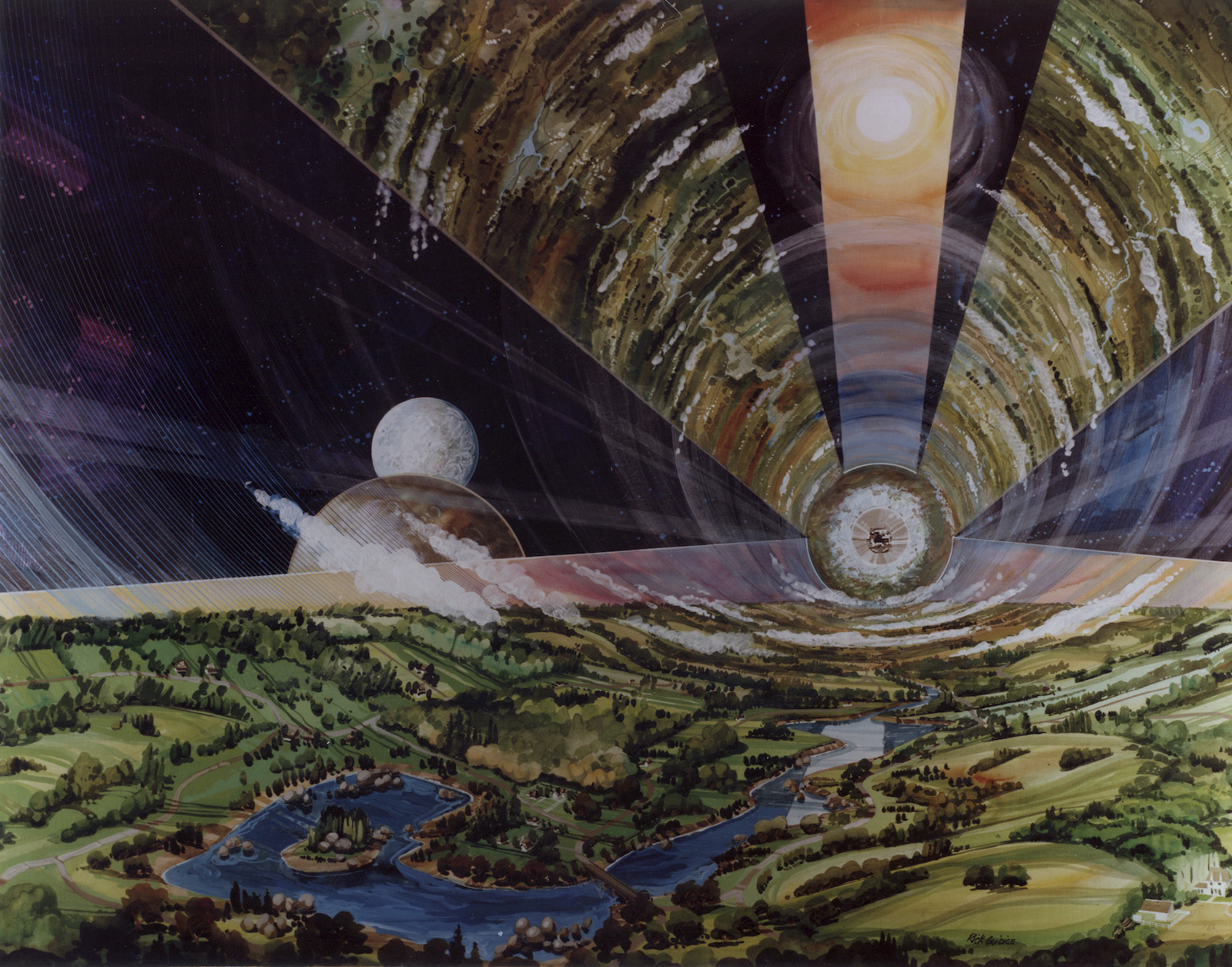
by DGR News Service | Sep 10, 2020 | Colonialism & Conquest
A new space race has begun. Private companies like SpaceX and Blue Origin have begun the process of privatizing the night sky. What comes next? Will humans colonize the solar system and beyond? In this third in a series of articles [Part 1, Part 2] Max Wilbert asks why this culture worships “progress.”
by Max Wilbert
“The mystery of life isn’t a problem to solve, but a reality to experience.”
– Frank Herbert
It began with wood and blood; trees and muscle power; the fire and the slave. This built the first megacities on Earth. The first civilizations grew: in Mesopotamia; along the Yangtze River and the Ganges; in the Andes; in Egypt; and elsewhere.
As they grew, they displaced other societies, tribes and nations who had existed for eons. By war or trade or marriage, assimilation or extermination, they grew, and as they grew, forests shrunk.
The limits of muscle and fire soon became apparent. By cutting down the forests, by plowing the earth and turning soil carbon into human carbon, they eroded the soil, they salinized the land, and what was a Fertile Crescent became dust. But these societies had created an ideology based on “more.” The result was war and a feverish search for new sources of energy and power.
The next frontier was to dig deeper, to find carbon that was buried deep under the soil in the crust of the planet itself. The burning of coal and oil was a revolution in energy. Suddenly mines could be pumped dry and shafts sunk deeper than ever before. Goods could be moved more quickly. Factories and war machines belched great clouds of smoke into the air, and the logging became industrial. The conversion of a living planet into a necropolis accelerated.
Coal and oil, when combined with the engineering necessary to create the engine, enabled expansion on a scale never before dreamed of. Soon nations had the power to move mountains, and they did. Coal and oil enabled the construction of the first large hydroelectric dams, and now the circulatory system of the planet was bound to civilization’s endeavors as well. And before long, the next boundary was breached: that of the atom itself.
This is the story of civilizations breaking the covenant humans had lived with for 200,000 years; the story of human beings constructing ideologies and megamachines that demand limitless power, and then pursuing that power to—quite literally—the end of the Earth.
Progress as Sort of God
There is a fundamental premise underlying not just capitalism, but all civilized societies: the premise is that “progress” in technological development is an inherent good; that any harm is overshadowed by this good; and that the pursuit of technological development and the power that results should be one of the primary goals of human society. Expansion is good. Growth is good.
This premise underlies not just capitalism, but civilization itself, and much of modern science.
This article is third in a series of essays responding to a scientific study published in the journal Scientific Reports back in May. The study models the future of global civilization, tracking population growth and deforestation, and finds that there is a 90 percent chance of civilization collapsing within the next 20-40 years. I discussed their collapse prediction in the first essay in this series.
The authors of the study theorize, as Salonika pointed out in the second essay, that the only way to avoid collapse is via expansion, especially expansion in energy generation, which they suppose would allow industrial civilization to surpass ecological limits and expand throughout the solar system. They write, “if the trajectory [of civilization’s technological development] has reached the Dyson limit we count it as a success [in our model], otherwise as failure.”
They are referring to a “Dyson Sphere” or “Dyson swarm,” a theoretical megamachine which would encompass a star and capture a large portion of its power output, which could then be used by a civilization.
The idea of a Dyson sphere has been around since the 1930’s, and has a rich life in science fiction. But it is not something to dismiss. Scientists have been working on the theoretical and technical foundation for space-based solar energy harvesting devices for many decades. More deeply, it is an idea that is deeply reflective of the ideology of civilization, which demands power in unlimited quantities. It is the same idea which has underlain civilization since the first slaves were shackled in rows and lashed and set to work building monumental architecture for the emperor. It is the same idea that drove the deforestation of the planet. It is the same idea that built the Grand Coulee Dam, and the Hoover Dam, and the Three Gorges Dam, and the Belo Monte Dam, and that will build the Batoka Gorge Dam unless we stop them. It is the same idea that has infected politicians and rulers and technocrats and theocrats and entire societies for thousands of years.
It is the idea that expansion is the highest good.
Exploitation as a Proxy for “Development”
It was not under capitalism but communism that Soviet astronomer Nikolai Kardashev coined the eponymous Kardashev scale in in his 1964 book Transmission of Information by Extraterrestrial Civilizations. The scale he proposes “is a method of measuring a civilization’s level of technological advancement based on the amount of energy they are able to use.”
The Kardashev scale ranks civilizations as Type I (a planetary civilization, which can use all the energy available on its planet of origin), Type II (which can use all the energy within a given star system), or Type III (galactic civilizations). In this scale, a Dyson sphere corresponds to a Type II civilization. Global civilization today, using Carl Sagan’s extrapolations, is approximately at Type 0.73.
In this scale, the more energy a society can appropriate for themselves, the more advanced they are.
- Those who have slaves can appropriate more energy than those who do not.
- Those who cut down the forest and burn it can appropriate more energy than those who do not.
- Those who plow the grasslands under can appropriate more energy than those who do not.
- Those who break the boundary of the atom will have more energy than those who do not.
- And those who are willing to capture sunlight itself—through a Dyson sphere or other forms of technology—will have more energy than those who do not.
It goes without saying that striving for higher levels on the scale is the goal of most people in power. From the beginning, most western science has been underpinned by a philosophy that the more human beings can control nature, the better. From Leonardo da Vinci and the Renaissance thinkers to Francis Bacon and the Royal Society, scientists have willingly hitched themselves to tyrants and democracies alike to fund their unending curiosity, and in return they have delivered weapons, energy, and economic development.
Control and expand: this is the ideology of conquest.
The Study of Consequences
Legendary science fiction author Frank Herbert wrote in his classic Dune that “ecology is the study of consequences.” The term is appropriate, then, to describe the study of the consequences unleashed by the decisions made by civilizations up to this point.
We’ve already spoken of the forests that are now past tense and the Fertile Crescent that is fertile no more. Agriculture—not gardening, but totalitarian agriculture—is no more than organized appropriation of primary productivity, habitat, and soil fertility from non-human species to benefit a single species (humans).
Primary productivity, or photosynthesis, is the basis of terrestrial ecology—the basis of life on land. On average, in agricultural areas, 83% of primary productivity is extracted by humans, leaving 17% for the non-humans who remain. This is a consequence of civilized agriculture, just as global warming and ocean acidification are consequences of the choice to seek energy from coal, petroleum, and natural gas.
The Fermi Paradox and The Great Filter
We cannot speak of civilization, Dyson spheres, and ecology without discussing the Drake equation and the Fermi Paradox.
Astronomer and astrophysicist Frank Drake created the Drake equation in 1961 at the first scientific meeting on the search for extraterrestrial intelligence, or SETI. The equation estimates the probability that there are other intelligent life forms in the galaxy with whom we might communicate. The equation is a rough tool, more thought experiment than precise scientific measure, and plugging in different variables can give wildly different results. It’s all conjecture; life has only ever been observed on one planet.
The Drake Equation, however, does suggest that there could be as many as 15 million planets with intelligent life in the Milky Way alone; we just don’t know. This is where the Fermi Paradox comes in. The Fermi Paradox is a mystery posited by Italian-American physicist Enrico Fermi: given these huge numbers, why have we found no evidence of extraterrestrial intelligence? A 2015 study concluded that Kardashev Type-III civilizations are either very rare or do not exist in the local Universe.”
Why has SETI failed?
There are many possible explanations, many of them revolving around the idea that the formation of complex life-forms is actually extremely rare, and that life on Earth has passed through some sort of “Great Filter” to arrive at this. An alternative explanation is that societies that develop the ability to transmit radio waves and travel off their own planet tend to destroy their own ecological founds and collapse.
Each of these explanations is horrifying in its own way.
The Colonization of Space
Incidentally, rockets used in spaceflight destroy the ozone layer, release as much carbon dioxide in 2 minutes as a car would produce in two centuries, and are changing the composition of the upper atmosphere, releasing gasses and particles in areas they have never before naturally existed. And this process is accelerating as corporations such as SpaceX, Blue Origin, and Virgin Galactic begin to colonize near-Earth orbit with thousands of satellites and increasing numbers of commercial craft.
It is expected that the number of rocket launches will increase by an order of magnitude within the next few years.
Another Path
Does it have to be like this?
Some would have us believe that science, technology, and progress are the only possibility—the only option that is thinkable. But is this true?
The science of conquest is not the only type of science. There is another; a science that is based on observation, thesis, and evidence, that is based on a peer-review that does not take place in university buildings, but rather in forests, in grasslands, along rivers, in the oceans.
This is the science of the Polynesian sailors, who set out across ten thousand miles of ocean on boats made of sustainably-harvested wood, who navigated the seas and found islands like a pin in the oceanic haystack without compasses, GPS satellites, or steel-hulled boats.
It is the science of the Kalapuya people, who practiced a scientific ecology through prescribed burning of their land, cultivating species beneficial to biodiversity and abundance not just for humans, but for all life, and thus gardened the entire landscape and created one of the most diverse habitats on Earth, and of the Klamath people, who use fire to geoengineer climate on a small scale by setting their hillsides alight when inversions cause the smoke to gather in their river valley, cooling the river and triggering the salmon runs.
It is the science of the Aborigines, who encoded language and culture in songlines and land, and created a continuous culture that has lasted at least 65,000 years. It is the science of those who remain, keeping these traditions alive, who often don’t use the term science, because it is too small a word for what they do.
There are other ways to live, ways that are no less complex or rewarding, no less respectful of human intellect, but which are build on relationship.
What future do we want? The dystopian future of science fiction? A world of control? A world of Dyson spheres and continental solar arrays? A world “red in tooth and claw,” where survival of the fittest means those who will extract more ruthlessly will gain power? Or do we want a world of connection and participation, a world of mutual aid, where we give back as much or more than we take?
I dream of a world where humans practice a different kind of science—not the science of conquest but the science of cooperation.
Max Wilbert is a writer, organizer, and wilderness guide. A third-generation dissident, he came of age in a family of anti-war and undoing racism activists in post-WTO Seattle. He is the editor-in-chief of the Deep Green Resistance News Service. His latest book is the forthcoming Bright Green Lies. His first book, an essay collection called We Choose to Speak, was released in 2018. He lives in Oregon.
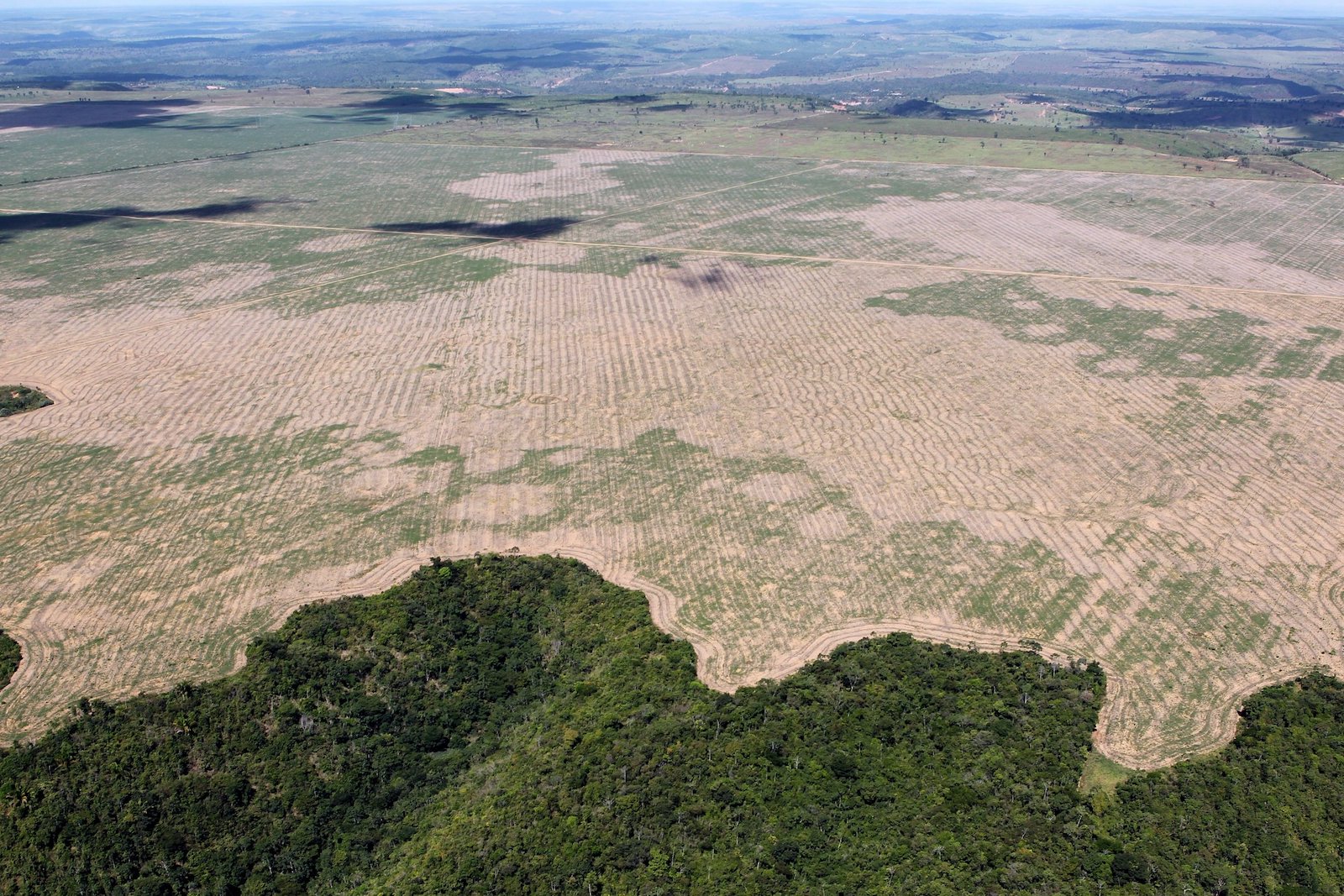
by DGR News Service | Jul 22, 2020 | Agriculture, Biodiversity & Habitat Destruction
Deforestation rate climbs higher as Amazon moves into the burning season
10 July 2020
- Deforestation in the Brazilian Amazon climbed higher for the fifteenth straight month, reaching levels not seen since the mid-2000s, according to data released today by Brazil’s national space research institute INPE.
- INPE’s satellite-based deforestation alert system detected 1,034 square kilometers of forest clearing during June 2020 bringing the twelve-month total to 9,564 sq km, 89% higher than a year ago.
- The extent of deforestation over the past year is the highest on record since INPE started releasing monthly numbers in 2007.
- The 12-month deforestation rate has risen 96% since President Jair Bolsonaro took office in January 2019.
Deforestation in the Brazilian Amazon climbed higher for the fifteenth straight month, reaching levels not seen since the mid-2000s, according to data released today by Brazil’s national space research institute INPE. The news comes as the region moves into the dry season, when deforestation and forest fires typically accelerate.
INPE’s satellite-based deforestation alert system detected 1,034 square kilometers of forest clearing during June 2020 bringing the twelve-month total to 9,564 sq km, 89% higher than a year ago. The extent of deforestation over the past year is the highest recorded since INPE started releasing monthly numbers in 2007.
The 12-month deforestation rate has risen 96% since President Jair Bolsonaro took office in January 2019.
Under pressure from big companies and the E.U. over rising deforestation and fire risk in the Amazon, the Bolsonaro Administration on Wednesday decreed a 120-day ban on fires in the Amazon. The administration had already deployed the army to the region to try to rein in burning, but fires are already well underway despite it being early in the dry season, according to analysis of satellite data by Amazon Conservation’s MAAP project.
MAAP found there are have been 14 major fires in the Amazon this year through July 2nd. MAAP’s analysis excludes fires in pasture and scrub lands, providing a clearer picture on fires associated with recent deforestation and in existing forest.
Deforestation has been trending upward in the Brazilian Amazon since 2012, but the rate of loss has dramatically accelerated over the past year-and-a-half as the Bolsonaro Administration has relaxed law enforcement, stripped conservation areas and indigenous lands of protection, promoted mining and industrial forest conversion, and tried to pass policies weakening environmental safeguards in the region.
Scientists have warned that the Amazon rainforest may be approaching a tipping point where the forest shifts toward a drier, savanna-like ecosystem. Such a transition could have significant and sustained impacts on local and regional rainfall patterns, while triggering the release of vast amounts of carbon into the atmosphere.
Published on the 10th July 2020, you can read the original and full article, with associated graphs and images here:














